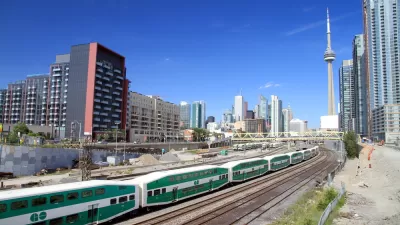Two of North America's largest railroads have prevented Montreal from electrifying the city's four commuter rail lines on tracks owned by freight rail. They claim that electrification would pose insurmountable structural problems for freight rail.
Andy Riga, the Gazette transportation reporter, describes the serious setback the Agence métropolitaine de transport has encountered. Electrification of public transit was a major part of the Montreal's climate action plan.
The two Class 1 railroads, Canadian National and Canadian Pacific which own most of the region's commuter rail tracks, will only allow electrification of a 7 km stretch of tracks used entirely by commuter rail, on one of the four lines that AMT hoped to electrify. A fifth line, the 30-kilometre Deux Montagnes line, was electrified from its beginning in 1918, and has been owned by AMT since 1996.
Canadian National claims to have advised AMT a year ago that due to "safety, engineering and operational obstacles", diesel freight and electric commuter trains "could not realistically coexist."
A Canadian Pacific spokesperson said AMT's proposal "would have required significant changes to our line, including ensuring the wire could clear our freight trains, such as trains moving double-stack containers." It could also "have required the raising of overhead structures, such as road overpasses."
"The AMT should follow Ontario's lead and buy tracks from railways, said Avrom Shtern of the Green Coalition environment group. "That would give the AMT control - a say on what happens" to its train lines.
"The AMT shouldn't close the door on electrification," said Normand Parisien of the transit users' group Transport 2000. The agency should start by electrifying tracks (on the 7 km stretch of rail not used by freight) on the Vaudreuil-Hudson line." (See You-Tube video of a train on that line)
"Electric trains attract more passengers because they're more reliable and comfortable," Parisien said
Riga investigates the extra cost AMT spent for the dual-mode (electric+diesel) locomotives when it appears they won't be necessary. They cost $15.4 million compared to the $5.2 million that Toronto's train authority paid for diesel locomotives in 2005.
Thanks to Clyde L. Anderson
FULL STORY: AMT mothballs electric train idea

Planetizen Federal Action Tracker
A weekly monitor of how Trump’s orders and actions are impacting planners and planning in America.

Maui's Vacation Rental Debate Turns Ugly
Verbal attacks, misinformation campaigns and fistfights plague a high-stakes debate to convert thousands of vacation rentals into long-term housing.

Restaurant Patios Were a Pandemic Win — Why Were They so Hard to Keep?
Social distancing requirements and changes in travel patterns prompted cities to pilot new uses for street and sidewalk space. Then it got complicated.

In California Battle of Housing vs. Environment, Housing Just Won
A new state law significantly limits the power of CEQA, an environmental review law that served as a powerful tool for blocking new development.

Boulder Eliminates Parking Minimums Citywide
Officials estimate the cost of building a single underground parking space at up to $100,000.

Orange County, Florida Adopts Largest US “Sprawl Repair” Code
The ‘Orange Code’ seeks to rectify decades of sprawl-inducing, car-oriented development.
Urban Design for Planners 1: Software Tools
This six-course series explores essential urban design concepts using open source software and equips planners with the tools they need to participate fully in the urban design process.
Planning for Universal Design
Learn the tools for implementing Universal Design in planning regulations.
Heyer Gruel & Associates PA
JM Goldson LLC
Custer County Colorado
City of Camden Redevelopment Agency
City of Astoria
Transportation Research & Education Center (TREC) at Portland State University
Jefferson Parish Government
Camden Redevelopment Agency
City of Claremont




























